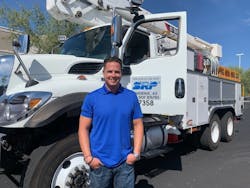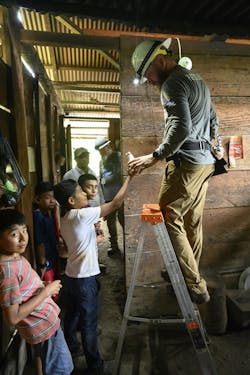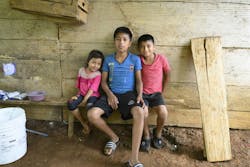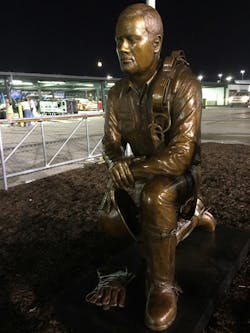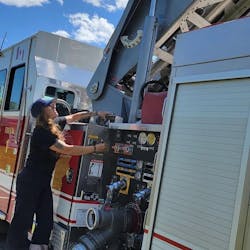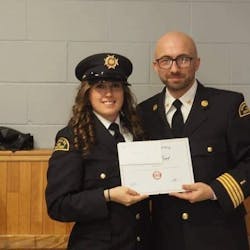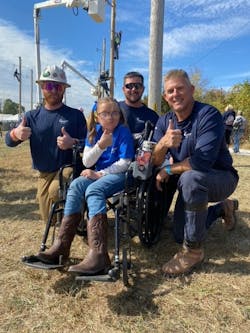Lineworkers Light Up Navajo Nation and Beyond: Stories of Service and Volunteerism Bringing First-Time Power to Communities
Lineworkers work from sunrise to sundown to keep the power flowing for customers. While everyone in the trade—from new apprentices to the seasoned journeymen—lives a life of service to their communities, some lineworkers pour their time and energy off the clock to help others in need.
Take for example Arthur William Muñoz, section supervisor for Salt River Project (SRP), who has spent more than two decades working in the line trade. Through the Light Up Navajo (LUN) Project, organized by the Navajo Tribal Utility Authority (NTUA) and American Public Power Association (APPA), he and 250 other volunteer lineworkers joined forces to provide first-time electricity to the Navajo Nation.
“We were productive and safe, and it was a fun environment to be in,” he says about his experience working this year in the northern Arizona section of Navajo Nation. “When lineworkers can get out of the city and get a chance to build overhead line in rural areas, they get excited and jump on the opportunity. The humanitarian effort is also beneficial for us as we are a prideful bunch and like to use our skillset to help wherever we are needed.”
Billy Patterson, journeyman lineworker for CKenergy Electric Cooperative in Binger, Oklahoma, agreed, saying volunteering to provide first-time power is life-changing and an experience he will never forget. He is a two-time volunteer for NRECA International’s program to wire homes in Guatemala, and he said it was amazing to be part of the lighting ceremony in the village.
“I’m grateful for being able to bring electricity to the Guatemalans,” he says. “I would also like to tell any other lineworkers who are thinking about volunteering on a project to just go. It will be life changing.”
While all lineworkers are heroes as first responders, the following special group lights the way for the line trade through their dedication to their communities and spirit of service.
Illuminating Navajo Nation
Nearly 23 years ago, Muñoz joined SRP as a young 25-year-old in a trade he knew nothing about or even had goals of trying to chase. He recalls feeling like he was in culture shock and thrown to the wolves.
“I knew I was blessed with an opportunity at a great company, and I wanted to work hard and see where it took me,” Muñoz says. “I ended up loving the trade and made it my goal to become a lineworker.”
After working as a trades helper for three-and-a-half years, he joined the apprenticeship program in 2006. As a fifth-step apprentice, he experienced one of his most memorable experiences as a lineworker—participating in SRP’s “climb and shake” inspection for its transmission towers. As part of this project, he rappelled off the side of a helicopter to the tip of Goat’s Peak.
“We get hoisted down with a winch line and disconnect once we reach the tower,” Muñoz says. “We then climb down and shake each part of the tower, looking for cracks, loose connections or rattles. I had never been in a helicopter before and never thought I would be hoisted down from one. It was crazy, wild and exciting at the same time and was a great experience I will never forget.”
When he topped out in 2010, he had another memorable experience—earning the David G. Hollis Award for the most outstanding apprentice of his class that year at SRP. He then worked as a lineworker on crews in various divisions for six years, eventually taking on the role of lead lineman.
“At that point in my career, I then decided to take the next leap and pursue a working foreman position,” he says. “I ran a crew for one year when I was given the opportunity to take on a role as a temporary section supervisor. Seven years later, here I am.”
Now as a section supervisor in SRP’s distribution maintenance division, he and his group maintain the distribution territory from a preventative and reactive perspective for both scheduled and emergency work. For example, he’s responsible for overseeing six reactive crews to build a cohesive, safe and productive workplace, and he ensures all employees are up to date on regulatory annual training. He also plans and organizes resources, equipment and personnel to respond to any trouble calls in a timely manner and collaborates with different groups at SRP.
Beyond his job at SRP, he also volunteered for the LUN Project to bring electricity to families in need on Navajo Nation. SRP partnered with 42 different utilities from 16 states in hopes of bringing power to 200 homes.
“SRP has been a part of this initiative from the beginning and has done an excellent job of spreading the word about it,” Muñoz says. “I had seen and heard about it when I worked in different groups, and I always had it in the back of my mind that it would be something I would like to be part of one day.”
For the fourth year SRP participated in the program, he jumped at the opportunity to give back to communities that needed help.
“Our division aids in mutual assistance to neighboring states, and I felt like I could be part of something big that could benefit a lot of people all while using my specific skillset,” he says. “Especially helping in our own state, it was rewarding and humbling at the same time.”
During the volunteer project, he managed and oversaw two crews, 12 employees and all the equipment. His typical day consisted of driving to the NTUA show up yard, having a tailboard, loading up material and driving out to the job. Once on site, the lineworkers built overhead line, dug pole holes, framed and set poles and strung and clipped in overhead line.
“My experience was excellent,” Muñoz says. “Every project we had ended up with energizing a customer to the power grid.”
As a volunteer for LUN, he was inspired by the Native American culture and how many of the residents live the way their ancestors did. Also, he had the opportunity to see how a different utility, the NTUA, operated and see their specifications.
He and the other lineworkers were stationed in a very remote area in northern Arizona, which presented a few key challenges like locating the areas to build power lines. While working off other utilities’ schematics and job prints was foreign to him, it was manageable, he says. Another challenge was using the latitude/longitude coordinate system.
“I was pleasantly surprised that using that system does work in our cell phones and guided us to the correct spot we needed to be,” he says.
One of the most memorable experiences was the appreciation dinner that NTUA hosted for the volunteers. The NTUA employees cooked dinner, and they invited all the customers they energized on their projects.
“We ‘broke bread’ together as they called it,” he says. “We got an opportunity to sit and get to know not only the employees, but also the people from the surrounding area. Representatives, employees and people said prayers, spoke and shared their culture with us. It was a very rewarding experience, and I will never forget it. We felt honored to be there.”
In the two weeks he and the SRP volunteers were on the project, they set 137 poles, strung 80,175 ft of overhead wire and 2,292 ft of secondary wire, set 16 overhead transformers and energized 17 customers.
“I saw extreme value from our folks out there and it was very appreciated,” he says. “I could tell that the community and NTUA really enjoyed having us there. We have built relationships with the community and employees. I saw firsthand the folks who had gone before embrace each other when they reunited. Our employees did an excellent job representing SRP and they should feel proud of their efforts. It was a win-win for our employees, the Navajo Nation and SRP.”
Glowing Lightbulbs in Guatemala
Lineworkers can not only power communities for the first time in America through LUN, but they can also travel overseas through the NRECA International program. One of the volunteers, Patterson, has worked in the line industry for the last dozen years and handles new construction and outages for his cooperative.
“I was drawn to line work because I’ve always enjoyed the outdoors, contributing to the community and hands-on work,” he says. “The challenging work plus the view from the bucket are just a few of the reasons I enjoy going to work each day.”
The most memorable moments of being a lineworker are the interactions he’s had with members of the co-op.
“On several occasions, people have gone out of their way to thank us or offer help,” he says. “They are always aware of our long and sleepless nights during storms. For instance, the morning after a tornado took a roof off a member’s home and destroyed his barn, he went into town to bring us all black coffee and donuts. This isn’t a rare occurrence. We are shown gratitude often.”
In addition to serving his own community through line work, Patterson also learned about an opportunity to volunteer in Guatemala from a presentation by Anna Politano, director of public relations and communications for the Oklahoma Association of Energy Cooperatives (OAEC).
“I was inspired by the stories of growth in resources and freed up time for new experiences that became available to the Guatemalans after having access to electricity,” he says.
He then put the inspiration into action by traveling to Guatemala with NRECA International in 2022 and 2023. During his 2022 trip, he spent three weeks building a power line for one village including more than 80 homes, an elementary school and a church.
“We were having to pull wire up and down mountainous terrain,” he recalls. “It was very hot and humid, which made climbing the poles more difficult.
The next year, he and the volunteer crews wired almost 200 structures through 38 villages. Because the lineworkers were working inside the homes, they worked closer with the villagers. One of his most memorable experiences was being able to see the inside of the villagers’ homes and how they live their day-to-day lives.
“They have dirt floors, palm roofs, an open fire to cook on and some have chickens roaming inside,” he recalls. “The river is where they wash their clothes, and women are seen carrying baskets or water jugs on their heads while being barefoot. Everyone is busy with their tasks but will stop in a moment’s notice to offer assistance if needed. It truly is amazing to watch how they make their community run smoothly with such little resources.”
In 2023, he and the volunteer crews stayed at the Fray Bartolome De Las Casas in Guatemala for 13 days. On a typical day, he woke up at 6 a.m. for breakfast, then loaded the trucks with materials and headed to new villages. When they arrived, they would discuss with the locals which homes or structures were on the list to be wired. After finishing wiring the homes and villages for the day, they would head back to their hotel, eat dinner and make bags with donations of necessities like toothbrushes from various cooperatives to give out to villagers.
Through his experience, he learned about the resiliency of the Guatemala villagers.
“Everyone in the village works together,” he says. “Even the children are eager to help. They are genuinely happy and appreciative. The experience helped me to be more conscious about remembering to appreciate the things we take for granted such as ice, air conditioning, lights, food, medicine and so much more.”
When rainfall saturated the mountainous terrain in Guatemala, it presented many challenges as far as building power lines.
“We had to climb every pole, and we did not have as many power tools as we would at home,” he says. “The language barrier also made some situations difficult. Our translators did a great job, but they could not be with all of us at once.”
At the same time, however, he says the opportunities were abundant and appreciated. He enjoyed being able to meet so many new people and create relationships with them in such short times.
“I really enjoyed getting to work with lineworkers from other co-ops and states,” he says.
He says what NRECA International and everyone else who contributes is doing to provide power to countries in need is truly inspiring.
“I’m beyond blessed and grateful to have been able to help in any way,” he says. “I went thinking I could help and change their lifestyles, but instead, I found that in return, the Guatemalans humbled me and taught me so much. Their down-to-earth personalities and love of the simple things in life will always stay with me,” he says. “I hope I can teach my children about their passion and resilience for living.”
Helping Line Families and Promoting the Trade
While lineworkers are volunteering to provide first-time power to families both overseas and here at home, they are also helping the line trade in other ways. For example, Chad Dubea founded the Fallen Linemen Organization (FLO) as a way to help the families of injured or fallen lineworkers.
As the son of a utility engineer, he spent his childhood summers visiting the Gulf State Power line crews and going up in the bucket.
“Early on, my upbringing with his work ethic really was an inspiration to me, and throughout my career in the industry,” he says.
When he was in high school, over the summers, he began working locally in line work, but he also traveled to south Texas and Louisiana, where he served on both transmission and distribution crews. During that time, he says he was fortunate to work with some of the best lineworkers in the area.
After building and operating his own business, T&D Solutions, and selling it to a private equity company, he searched for a way to give back to an industry that was so good to him and his family. Back in 2012, he looked to see if there was a foundation to help fallen linemen, and he could only find foundations to help other first responders like police officers and firefighters. He then launched the Fallen Linemen Organization (FLO) to help line families in need.
Through a collaboration with the National Sisterhood United of Journeymen Linemen (NSUJL), the FLO gave out nearly $100,000 to help families of wounded or fallen lineworkers. So far in 2024, the organization has already helped eight families.
“There’s definitely a need out there, and the main goal of the FLO is to reduce incidents,” he says. “We hope one day to not have to help any families. When the incidents are down, we can put those funds into doing more research and development on safer and more effective things for our industry.”
To request assistance, families of fallen or wounded lineworkers can fill out an application on FLO’s website. The board then meets to review the application and disburses funds for everything from the cost of funerals to bills that need to be paid. Because a lot of the funding comes from donations and volunteers, the FLO is focusing more on social media and marketing.
“We want to make sure that we are helping all families of fallen and wounded linemen,” he says. “We don’t separate from union or non-union—we help all families in our industry.”
To further honor fallen lineworkers, Dubea and his team also commissioned a bronze memorial statue, which was inspired by a work-related fatality that happened years ago. This statue is now housed in a training facility in Texas, but in the near future, it will be relocated to the new home of the International Lineman’s Museum in Florida.
“We’re getting a plan together to hopefully get the industry involved with this great thing that we’re doing with the museum and the memorial to highlight our industry,” he says.
Beyond the FLO, Dubea also promoted the line trade through various ventures including helping to fund the NASCAR race, “Drivin’ for Linemen” in St. Louis for four years.
“One year we had a truck that we sponsored that went around the country that was dedicated to all electrical linemen,” he says. “I think that was a way for us to get the line industry out to people.”
In addition to securing the naming rights for the race, they also collaborated with Bob Hall of Buckingham Manufacturing to organize the Climbin for Linemen the day before the race. Lineworkers could participate in competitions to win prizes including a trip to Mexico.
“That was a really great experience, and we loved being part of NASCAR,” he says. “We went in a different direction, but I really enjoyed that time of doing Drivin for Linemen.”
To raise awareness of the line trade, Dubea also served as the executive producer of the Hollywood movie, “Life on the Line,” starring John Travolta as a lineworker. Travolta learned how to climb a pole at a Texas training facility and also met with the wives of fallen lineworkers during the filming.
“It was a great experience, and I was honored and grateful to do it,” he says. “I’m very proud of the work we did to actually get the movie out..”
Through the production of the movie, he says the team focused on getting the information out to people who didn’t know about the industry and getting the spouses involved.
“In the beginning of the movie, when the guys are going out for a storm, his wife tells him to be safe,” Dubea says. “A lot of times, I don’t think lineworkers talk about their day. I really wanted to show the spouses the dangers of those lineworkers out in the field because they may not understand the dangers out there and what they are dealing with.”
The third thing he wanted to get across through the movie was bridging the union/non-union gap.
“I wanted to show that we can work together, we are lineworkers and it doesn’t matter what our affiliation is,” he says. “We all work in this industry together, and we all want to get home safe to our families, and it shouldn’t matter what company we work for.”
Finally, he wanted to let people know the dangers of the industry.
“The year we did the movie, we lost a lot of lineworkers, and so we wanted to get that information out there so people could recognize that this is a dangerous job that can be done safely,” he says.
Dubea says that he has loved his career in the line trade, and he urges all lineworkers out there to do more than they are expected to do.
“Don’t let anybody hold you back,” he says. “If you get opportunity, capture it and do the best you can do. I encourage everybody to put your heart into it. It’s not just a job—it’s a career. We should be so very honored and proud of what we are doing to bring everybody the electricity they demand. I just love this industry, and it’s great to be a part of.”
Fighting Fires and Saving Lives
Lineworkers are serving their communities each and every day by keeping the power on, but some are going above and beyond by volunteering in other public service roles. Take Melissa Dawe, a fourth-year apprentice with Connect Atlantic Utility Services in Nova Scotia, Canada. The volunteer firefighter first observed the professionalism and skills of powerline workers during both routine and storm restoration work when she was a traffic controller.
“I did a lot of flagging work for them during their daily work and storms,” she says.
After running new fiber and doing underground work as a cable line technician for a utility, she joined her current company, where she focuses on upgrading and maintaining power lines. She has also traveled to the United States for storm response, most recently for Hurricane Fiona.
“We worked 22 days straight to get power back on to customers and even after those 22 days our regular day-to-day work was still part of fixing some of the infrastructure from the damage done by Hurricane Fiona,” she says. “This hurricane had caused major damages to homes and power lines.”
Beyond her career in the line trade, Dawe is also giving back to the community as a volunteer firefighter. Eight years ago, she joined the Florence Fire Department.
“I’ve always wanted to help people,” says Dawe, who was featured in T&D World’s new Faces of the Future department and related podcast series. “I trained hard and volunteered time for fundraisers.”
After volunteering with the fire department for five years, she moved to Springhill, Nova Scotia, to go to school for powerline. As soon as she got to her new location, she knew she wanted to continue to help the community as a firefighter, so she joined the local fire department in May 2020.
“In the fire service, you always hear about brotherhood and family,” she says. “Well, in both departments, this was true. They were—and still are—my second family. Through all the bad calls, we stick together, and we always keep each other safe.”
Dawe, the mom of two sons—11-year-old Ethan and 8-year-old Alexander, says she takes pride in being a firefighter.
“I have done a lot of medical calls, car accidents and structure fires,” she says. “When you do get those bad calls, you always remember all the good ones because that’s what keeps you going.”
Climbin4 Kids: Supporting St. Judes
Throughout their service territory, Ameren Illinois lineworkers help others in need in their communities. For example, two journeymen lineworkers—Paul Koehler and Jason Novak—have joined forces to support the Climbin4 Kids fundraiser for St. Jude Children’s Research Hospital.
“It was started by my friend, Jason, and inspired by my daughter, Guiliana, who passed away from a brain tumor in 2022 at 10 years old,” says Koehler, an Ameren Illinois crew leader who has spent the last 23 years in the line trade. “We raised $150,000 in just three years and met families and people along the way.”
Two years ago, with the support of their company, Ameren Illinois, the internal fundraiser generated $15,000 for St. Jude while an additional $5,000 was raised externally. The International Lineman’s Rodeo Association (ILRA) also donated $1,000 to the cause, bringing the grand total to $44,000.
That year, Koehler and Novak were able to bring their families on stage to present the check to St. Jude, which will go down in history as their fondest Lineman’s Rodeo and Climbin4Kids memory.
“I was touched by the strength and character shown by them,” says Novak, a line crew foreman for Ameren Illinois with 31 years in the trade. “Paul has since joined in the fundraising efforts and has been a great asset.”
Last year, the fundraising program raised more than $110,000 with the help from Ameren, the ILRA, industry manufacturers and lineworkers from across the country.
“We are proud to say that 100% of every dollar that Climbin4Kids has raised has gone directly to St. Jude,” Novak says. “It has truly been a blessing being a part of this. We have a lot of help spreading the word and helping in our fundraising efforts. We have heard countless stories of the help that St. Judes has provided families within our line community.”
While many executives, support staff and field workers at Ameren and other utilities have supported the cause over the last few years, the idea for the program can be traced back to 2021. Novak was set to compete for the 20th time at the International Lineman’s Rodeo, and he wanted to do something different that year. Inspiration struck at church when he and his family listened to a testimony about St. Jude, and it touched his heart.
Because his utility wasn’t sending any teams to the International Lineman’s Rodeo that year, he asked his teammates if they wanted to compete as the Climbin4Kids team and donate any money raised to St. Jude. The very first fundraiser was done by his daughter, Bristol, who raised more than $60 selling items, hot chocolate and lemonade at a garage sale. His team also asked for donations at the International Lineman’s Rodeo Week and that year, they raised $5,500. Raising money for St. Jude has definitely been a learning experience for him and his team member, Koehler.
“As lineworkers, we are not used to asking for help, however, we are learning the value of it,” he says. “There are many people who volunteer their time, and we greatly appreciate it.”
Koehler says it can be challenging to spread the word, but once people hear about the mission of Climbin4Kids, they usually donate.
“We are giving back and raising money for families when they need it the most,” says Koehler, who worked for a municipal electric and contractor before joining Ameren Illinois 15 years ago. “We’ve met new people who have had similar experiences and wanted to help us.”
Novak says they now have people helping throughout the country, and they can’t thank them enough for their generosity.
“Industry manufacturers have gone above and beyond donating items to be raffled,” he says. “We now have companies wanting to do fundraising within their own organizations and donating the proceeds to Climbin4Kids. We are a blessed and giving community, and it’s great seeing the amazing support the line families are doing.”

